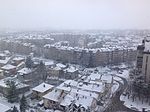Pupin Bridge
2014 establishments in SerbiaBridges completed in 2014Bridges in BelgradeBridges over the DanubeConcrete bridges ... and 4 more
Girder bridgesPalilula, BelgradeRoad bridges in SerbiaZemun

The Pupin Bridge (Serbian Cyrillic: Пупинов мост, romanized: Pupinov most) is a road bridge over the Danube River in Belgrade, Serbia. The bridge is located upstream of the city center and connects Belgrade neighbourhoods of Zemun and Borča. It is part of Semi-Inner Ring circle. Opened in December 2014, it became the second bridge over the Danube in Belgrade, after the Pančevo Bridge in 1946.
Excerpt from the Wikipedia article Pupin Bridge (License: CC BY-SA 3.0, Authors, Images).Pupin Bridge
Спољна магистрална тангента, Palilula Urban Municipality
Geographical coordinates (GPS) Address External links Nearby Places Show on map
Geographical coordinates (GPS)
| Latitude | Longitude |
|---|---|
| N 44.8645 ° | E 20.3811 ° |
Address
Пупинов мост
Спољна магистрална тангента
11000 Palilula Urban Municipality
Central Serbia, Serbia
Open on Google Maps








